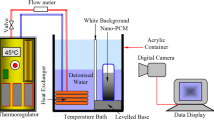Abstract
To investigate the efficiency of nanoparticles as nucleation agents in polyol cryoprotectant solutions at cryogenic temperatures, the nucleation and devitrification temperatures of these solutions with different concentrations of diamond, gold, copper–nickel, and silicon nanoparticles were measured through differential scanning calorimetry. The results show that ice growth in these cryoprotectant solutions is prominently accelerated by nanoparticles and the devitrification temperatures of cryoprotectant solutions are significantly lowered by nanoparticles. These findings can be used to improve the efficiency of cell cryopreservation procedures and open numerous avenues of investigations regarding the application of nanoparticles in cryogenics.


Similar content being viewed by others
References
Baudot A, Odagescu V (2004) Thermal properties of ethylene glycol aqueous solutions. Cryobiology 48:283–294
Burke MJ, Lindow SE (1990) Surface properties and size of the ice nucleation site in ice nucleation active bacteria: theoretical considerations. Cryobiology 27:80–84
Carlberg KE, Lindsey CB (1989) Ice making method using ice-nucleating microorganisms. US Patent 4,796,805
Charoenrein S, Reid DS (1989) The use of DSC to study the kinetics of heterogeneous and homogeneous nucleation of ice in aqueous systems. Thermochim Acta 156(2):373–381
Choi SUS, Zhang ZG, Yu W, Lockwood FE, Grulke EA (2001) Anomalous thermal conductivity enhancement in nanotube suspensions. Appl Phys Lett 79:2252–2254
Diller KR (1985) The influence of controlled ice nucleation on regulating the thermal history during freezing. Cryobiology 22:268–281
Fletcher NY (1958) Size effect in heterogeneous nucleation. J Chem Phys 29:572–576
Hobbs PV (1974) Ice physics. Clarendon, Oxford
Jang SP, Choi SUS (2004) Role of Brownian motion in the enhanced thermal conductivity of nanofluids. Appl Phys Lett 84:4316–4318
Kang H, Kim S, Myung J (2006) Estimation of thermal conductivity of nanofluid using experimental effective particle. Exp Heat Trans 19:181–191
Klaassen C, Amdur M, Doull J (1996) Casarett and Doull’s Toxicology. The basic science of poisons. 5th edn. Pergamon, New York
Kojima T, Soma T, Oguri N (1988) Effect of ice nucleation by droplet of immobilized silver iodide on freezing of rabbit and bovine embryos. Theriogenology 30:1199–1207
Li JK, Lee TC (1995) Bacterial ice nucleation and its potential application in the food industry. Trends Food Sci Technol 6:259–265
Ma HB, Wilson C, Borgmeyer B, Park K, Yu Q (2006) Effect of nanofluid on the heat transport capability in an oscillating heat pipe. Appl Phys Lett 88:143116–1 143116–3
MacKenzie AP (1977) Non-equilibrium freezing behavior of aqueous systems. Phil Trans R Soc Lond B 278:167–189
Maki LR, Galyan EL, Chang-Chien MM, Caldwell DR (1974) Ice nucleation induced by Pseudomonas syringae. Appl Microbiol 28:456–459
Muldrew K, McGann LE (1990) Mechanisms of intracellular ice formation. Biophys J 57:525–532
Ren HS, Wei Y, Hua TC, Zhang T (1994) Theoretical prediction of vitrification and devitrification tendencies for cryoprotective solutions. Cryobiology 31:47–56
You SM, Kim JH (2003) Effect of nanoparticles on critical heat flux of water in pool boiling heat transfer. Appl Phys Lett 83:3374–3376
Yu W, Choi SUS (2003) Role of interfacial layers in the enhanced thermal conductivity of nanofluid: a renovated maxwell model. J Nanopart Res 5:167–171
Zhang X, Fujii M (2000) Measurements of thermal conductivity and electrical conductivity of a single carbon fiber. Int J Thermophys 21:965–980
Author information
Authors and Affiliations
Corresponding author
Rights and permissions
About this article
Cite this article
Han, X., Ma, H.B., Wilson, C. et al. Effects of nanoparticles on the nucleation and devitrification temperatures of polyol cryoprotectant solutions. Microfluid Nanofluid 4, 357–361 (2008). https://doi.org/10.1007/s10404-007-0186-z
Received:
Accepted:
Published:
Issue Date:
DOI: https://doi.org/10.1007/s10404-007-0186-z




